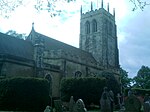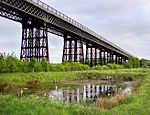Giltbrook
Giltbrook is a village in England situated approximately 6 miles (9.7 km) northwest of Nottingham and within close reach of junction 26 of the M1 motorway. It is part of Greasley (Giltbrook and Newthorpe) ward, which had a population of 6,076 in 2001, increasing to 6,233 at the 2011 Census.The name Giltbrook is believed to come from the old English name "Gylden Broc", which means golden stream, or brook. This relates to the brook that runs from the fields to the north of IKEA, and then continues under Nottingham Road at Giltbrook, and under the IKEA entrance, finally flowing into the River Erewash. Notable events include Giltbrook being the end point of the Pentrich rising where a small force of soldiers: twenty men of the 15th Regiment of Light Dragoons ended the rising. Some streets have been named after the ring leaders, with names such as Brandreth, Turner and Ludlam being used. The village is home to the Giltbrook Retail Park which has been developed due to the presence and popularity of IKEA, Decathlon and a Next store. In 2008 a whole retail park was built on the land next to IKEA, including Pets at Home, Laura Ashley, Comet, BHS, Boots, and Carpet Right. Comet, BHS and Laura Ashley have now ceased trading, being replaced by TK Maxx, Marks & Spencer and DFS respectively. Other local businesses include the head office of Essentra Packaging, one pub, the Hayloft, a cob shop, a fish and chip shop, a hairdressers, a Chinese takeaway, carpet shop, plumbing shop and a garage. Giltbrook was previously home to the New White Bull public house which dated back to the turn of the 19th century. After failed attempts to save the pub, it closed on 7 January 2015 to make way for the development of a Co-operative Food store.Giltbrook is represented on the Broxtowe Borough Council by three Conservative councillors, Nottinghamshire County Council by one independent councillor and the House of Commons by Conservative MP Darren Henry. One notable person who was born in Giltbrook was the undefeated bare knuckle fighter and boxer, Bartley Gorman, known as King of the Gypsies.
Excerpt from the Wikipedia article Giltbrook (License: CC BY-SA 3.0, Authors).Giltbrook
Nottingham Road, Broxtowe
Geographical coordinates (GPS) Address Nearby Places Show on map
Geographical coordinates (GPS)
| Latitude | Longitude |
|---|---|
| N 53.007 ° | E -1.283 ° |
Address
Nottingham Road
Nottingham Road
NG16 2FN Broxtowe
England, United Kingdom
Open on Google Maps





